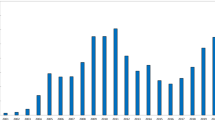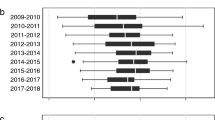Abstract
Bovine tuberculosis (TB) is one of the most complex, persistent and controversial problems facing the British cattle industry, costing the country an estimated £100 million per year1. The low sensitivity of the standard diagnostic test leads to considerable ambiguity in determining the main transmission routes of infection, which exacerbates the continuing scientific debate2,3,4,5,6. In turn this uncertainty fuels the fierce public and political disputes on the necessity of controlling badgers to limit the spread of infection. Here we present a dynamic stochastic spatial model for bovine TB in Great Britain that combines within-farm and between-farm transmission. At the farm scale the model incorporates stochastic transmission of infection, maintenance of infection in the environment and a testing protocol that mimics historical government policy. Between-farm transmission has a short-range environmental component and is explicitly driven by movements of individual cattle between farms, as recorded in the Cattle Tracing System2. The resultant model replicates the observed annual increase of infection over time as well as the spread of infection into new areas. Given that our model is mechanistic, it can ascribe transmission pathways to each new case; the majority of newly detected cases involve several transmission routes with moving infected cattle, reinfection from an environmental reservoir and poor sensitivity of the diagnostic test all having substantive roles. This underpins our findings on the implications of control measures. Very few of the control options tested have the potential to reverse the observed annual increase, with only intensive strategies such as whole-herd culling or additional national testing proving highly effective, whereas controls focused on a single transmission route are unlikely to be highly effective.
This is a preview of subscription content, access via your institution
Access options
Subscribe to this journal
Receive 51 print issues and online access
$199.00 per year
only $3.90 per issue
Buy this article
- Purchase on SpringerLink
- Instant access to full article PDF
Prices may be subject to local taxes which are calculated during checkout



Similar content being viewed by others
References
Department for Environment Food and Rural Affairs. Bovine Tuberculosis Evidence Plan (2013)
National Audit Office. Identifying and Tracking Livestock in England (2003)
Waddington, K. To stamp out “so terrible a malady”: bovine tuberculosis and tuberculin testing in Britain, 1890–1939. Med. Hist. 48, 29–48 (2004)
Reynolds, D. A review of tuberculosis science and policy in Great Britain. Vet. Microbiol. 112, 119–126 (2006)
Krebs, J. The Independent Scientific Review Group. Bovine Tuberculosis in Cattle and Badgers (1997)
Gopal, R., Goodchild, A., Hewinson, G., de la Rua Domenech, R. & Clifton-Hadley, R. Introduction of bovine tuberculosis to north-east England by bought-in cattle. Vet. Rec. 159, 265–271 (2006)
The Independent Scientific Group on Cattle TB. Bovine TB: The Scientific Evidence (2007)
Department for Environment Food and Rural Affairs. Bovine TB Eradication Programme for England http://www.defra.gov.uk/publications/files/pb13601-bovinetb-eradication-programme-110719.pdf (2011)
Pollock, J. M. et al. Immune responses in bovine tuberculosis. Tuberculosis (Edinb.) 81, 103–107 (2001)
Green, L. E. & Cornell, S. J. Investigations of cattle herd breakdowns with bovine tuberculosis in four counties of England and Wales using VETNET data. Prev. Vet. Med. 70, 293–311 (2005)
Monaghan, M. L., Doherty, M. L., Collins, J. D., Kazda, J. F. & Quinn, P. J. The tuberculin test. Vet. Microbiol. 40, 111–124 (1994)
Conlan, A. J. K. et al. Estimating the hidden burden of bovine tuberculosis in Great Britain. PLOS Comput. Biol. 8, e1002730 (2012)
Keeling, M. J. et al. Dynamics of the 2001 UK foot and mouth epidemic: stochastic dispersal in a heterogeneous landscape. Science 294, 813–817 (2001)
Ferguson, N. M., Donnelly, C. A. & Anderson, R. M. The foot-and-mouth epidemic in Great Britain: pattern of spread and impact of interventions. Science 292, 1155–1160 (2001)
Barlow, N. D., Kean, J. M., Hickling, G., Livingstone, P. G. & Robson, A. B. A simulation model for the spread of bovine tuberculosis within New Zealand cattle herds. Prev. Vet. Med. 32, 57–75 (1997)
Fischer, E. A. J., van Roermund, H. J. W., Hemerik, L., van Asseldonk, M. A. P. M. & de Jong, M. C. M. Evaluation of surveillance strategies for bovine tuberculosis (Mycobacterium bovis) using an individual based epidemiological model. Prev. Vet. Med. 67, 283–301 (2005)
Woolhouse, M. E. J. et al. Epidemiological implications of the contact network structure for cattle farms and the 20–80 rule. Biol. Lett. 1, 350–352 (2005)
Green, D. M., Kiss, I. Z., Mitchell, A. P. & Kao, R. R. Estimates for local and movement-based transmission of bovine tuberculosis in British cattle. Proc. R. Soc. B 275, 1001–1005 (2008)
Blower, S. M. et al. The intrinsic transmission dynamics of tuberculosis epidemics. Nature Med. 1, 815–821 (1995)
Cox, D. R. et al. Simple model for tuberculosis in cattle and badgers. Proc. Natl Acad. Sci. USA 102, 17588–17593 (2005)
Brooks-Pollock, E. et al. Age-dependent patterns of bovine tuberculosis in cattle. Vet. Res. 44, 97 (2013)
O’Hare, A., Orton, R. J., Bessell, P. R. & Kao, R. R. Estimating epidemiological parameters for bovine tuberculosis in British cattle using a Bayesian partial-likelihood approach. Proc. R. Soc. B 281, 20140248 (2014)
Sisson, S. A., Fan, Y. & Tanaka, M. M. Sequential Monte Carlo without likelihoods. Proc. Natl Acad. Sci. USA 104, 1760–1765 (2007)
Toni, T., Welch, D., Strelkowa, N., Ipsen, A. & Stumpf, M. P. Approximate Bayesian computation scheme for parameter inference and model selection in dynamical systems. J. R. Soc. Interface 6, 187–202 (2009)
Donnelly, C. & Hone, J. Is there an association between levels of bovine tuberculosis in cattle herds and badgers? Stat. Commun. Infect. Dis. 2, (2010)
Godfray, H. C. J. et al. A restatement of the natural science evidence base relevant to the control of bovine tuberculosis in Great Britain. Proc. R. Soc. B 280, 20131634 (2013)
Acknowledgements
This work was funded by BBSRC, the Wellcome Trust and EPSRC. We would like to thank G. Medley, L. Green, O. Courtenay, A. Ramirez-Villaescusa, J. Wood and L. Danon for helpful discussions on bovine TB dynamics. Thanks to A. Conlan and T. J. McKinley for advice on implementing SMC-ABC and to A. Conlan to setting up the Marx Bros cluster. The breakdown and reactor data was supplied by the AHVLA team (particularly A. Mitchell and R. Blackwell), the RADAR team and DEFRA.
Author information
Authors and Affiliations
Contributions
M.J.K. and E.B.-P. developed the model structure; E.B.-P. and G.O.R. developed the statistical methodology; all authors contributed to the writing of the manuscript.
Corresponding author
Ethics declarations
Competing interests
The authors declare no competing financial interests.
Extended data figures and tables
Extended Data Figure 1 Historic testing patterns and identification of infected cattle.
a, Number of single intradermal comparative cervical tuberculin (SICCT) tests carried out on cattle according to the reason for the test (test type). b, Number of reactors (cattle testing positive) by test type. Tests shown are: 12 month follow-up test (12M), 6 month follow-up test (6M), contiguous test (CON), check test (CT), pre-movement testing (PRMT), routine herd test (RHT), follow-up tests at sixty-day intervals (SI) and whole-herd tests (WHT).
Extended Data Figure 2 Prior and posterior distributions for the model parameters.
Prior distributions (dashed lines) reflect captures uncertainty in the seven different parameters; only the test sensitivity, ρ, has a relatively informative prior based on estimates in the literature. Red curves show the posterior distribution as given by the ABC-SMC algorithm (see Supplementary Material).
Extended Data Figure 3 Data–model comparisons.
a, The number of reactors per year; b, the number of failed herd tests; c, observed and expected number of reactors per county and year; d, the observed and expected number of failed tests (at the herd level, per county and year); e, the observed and expected number of reactors and failed tests using logarithmic binning; f, the number of reactor cattle found per failed test. The error bars and red shaded regions denote the 95% prediction intervals; the yellow region in a and b shows the range from 5,000 simulations.
Extended Data Figure 4 Observed and expected number of reactors per county per year.
The expected value for each county and year is calculated as the (weighted) mean number of reactors produced by simulations using the posterior parameter sets, from 5,000 simulations.
Extended Data Figure 5 A comparison of testing strategies using the stochastic model.
a–d, The predicted model output compared to baseline predictions at the start (2005) and end (2010) of the implementation, for the ten controls listed in the Supplementary information and Extended Data Table 2, for reactors (a), cattle culled (b), herds tested (c) and herds under restrictions (d). e, For the baseline case and seven control measures listed in the main paper, the change in number of reactors at a county scale. Counties are aggregated into four bins (x axis) based on the number of reactors one year, and the expected number of reactors in the next year is shown on the y axis. Error bars denote the 95% prediction intervals.
Supplementary information
Supplementary Information
This file contains Supplementary Text and Data 1-8 and additional references. (PDF 220 kb)
Rights and permissions
About this article
Cite this article
Brooks-Pollock, E., Roberts, G. & Keeling, M. A dynamic model of bovine tuberculosis spread and control in Great Britain. Nature 511, 228–231 (2014). https://doi.org/10.1038/nature13529
Received:
Accepted:
Published:
Issue Date:
DOI: https://doi.org/10.1038/nature13529
This article is cited by
-
Selective breeding can contribute to bovine tuberculosis control and eradication
Irish Veterinary Journal (2023)
-
Treatment of sheep prior to movement: its contribution to an effective scab (psoroptic mange) management strategy
Parasites & Vectors (2023)
-
Diagnostic accuracy of the Enferplex Bovine Tuberculosis antibody test in cattle sera
Scientific Reports (2023)
-
Occupational exposure and challenges in tackling M. bovis at human–animal interface: a narrative review
International Archives of Occupational and Environmental Health (2021)
-
Multi-species temporal network of livestock movements for disease spread
Applied Network Science (2021)



